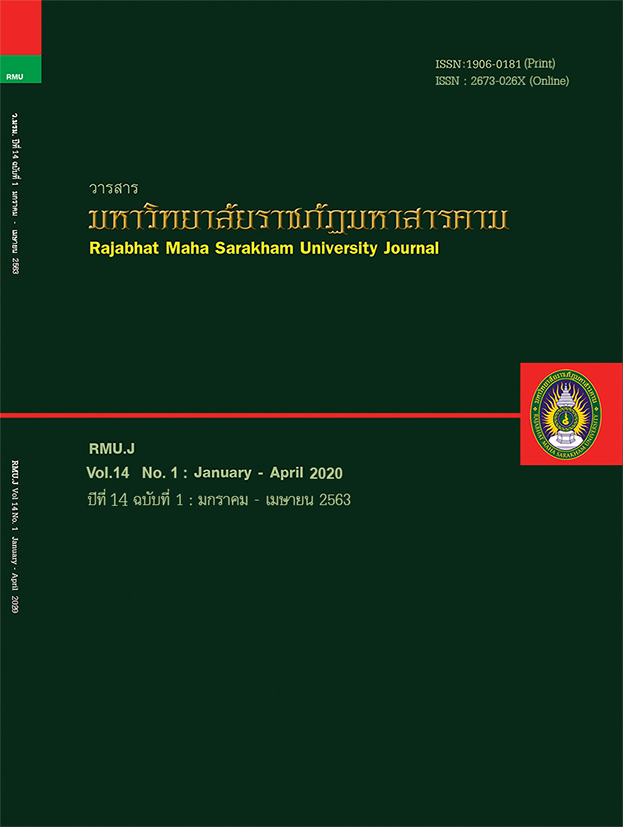การวัดมูลค่าทุนทางปัญญาของบริษัทจดทะเบียนในตลาดหลักทรัพย์แห่งประเทศไทย
Main Article Content
บทคัดย่อ
การวิจัยนี้มีวัตถุประสงค์เพื่อศึกษาทุนทางปัญญาของบริษัทจดทะเบียนในตลาดหลักทรัพย์แห่งประเทศไทย.และเพื่อวิเคราะห์มูลค่าเพิ่มทุนทางปัญญา ของบริษัทจดทะเบียนในตลาดหลักทรัพย์แห่งประเทศไทย โดยการทบทวนเอกสาร ตำรา งานวิจัยที่เกี่ยวข้อง และทำการเก็บรวบรวมข้อมูลจากบริษัทจดทะเบียนในตลาดหลักทรัพย์แห่งประเทศไทย จากแบบ 56 - 1 รายงานประจำปีของบริษัทระหว่าง ปี พ.ศ. 2556 – 2560 รวมเป็นจำนวน 240 บริษัท ทั้งหมด 8 กลุ่มอุตสาหกรรม ผู้วิจัยได้ใช้ Value Added Intellectual Coefficient (VAIC) ในการวัดมูลค่าทุนทางปัญญาของบริษัทจดทะเบียนในตลาดหลักทรัพย์แห่งประเทศไทย ซึ่งเป็นวิธีที่ได้รับการยอมรับในการวัดทุนทางปัญญาของบริษัท เกี่ยวกับประสิทธิภาพ หรือความสามารถในด้านการบริหารบริษัท ตัวบ่งชี้ที่ใช้ในการวัดประสิทธิภาพ ของการใช้ทรัพยากร เพื่อบริหารองค์กร
ผลการวิจัยพบว่า บริษัทจดทะเบียนในตลาดหลักทรัพย์แห่งประเทศไทย มีมูลค่าเพิ่มทุนทางปัญญาอยู่ในระดับสูง โดยค่าสัมประสิทธิ์ประสิทธิภาพทุนมนุษย์ โดยรวมมีค่าสูงสุด และบริษัทจดทะเบียนในตลาดหลักทรัพย์แห่งประเทศไทยได้มีการสนับสนุน จึงทำให้เกิดมูลค่าเพิ่มทุนทางปัญญา ถ้าจำแนกตามประเภท กลุ่มอุตสาหกรรม พบว่า กลุ่มอุตสาหกรรมอุปโภคบริโภค มีค่าสัมประสิทธิ์การใช้ทุนมากกว่า กลุ่มอุตสาหกรรมอื่น และบริษัทจดทะเบียนในตลาดหลักทรัพย์แห่งประทศไทยมีมูลค่าเพิ่มทุนทางปัญญาอยู่ในระดับสูง
Article Details
1. บทความที่ลงตีพิมพ์ทุกเรื่องได้รับการตรวจทางวิชาการโดยผู้ประเมินอิสระ ผู้ทรงคุณวุฒิ (Peer Review) สาขาที่เกี่ยวข้อง อย่างน้อย 3 ท่าน ในรูปแบบ Double blind review
2. ข้อคิดเห็นใด ๆ ของบทความที่ลงตีพิมพ์ในวารสารมหาวิทยาลัยราชภัฏมหาสารคาม นี้เป็นของผู้เขียน คณะผู้จัดทำวารสารไม่จำเป็นต้องเห็นด้วย
3. กองบรรณาธิการวารสารมหาวิทยาลัยราชภัฏมหาสารคาม ไม่สงวนสิทธิ์การคัดลอกแต่ให้อ้างอิงแสดงที่มา
เอกสารอ้างอิง
ตลาดหลักทรัพย์แห่งประเทศไทย. (2561). ข้อมูลบริษัท/หลักทรัพย์.https://www.set.or.th/set/ mainpage.do? language th & country=TH. พฤษภาคม 2561.
บุญชม ศรีสะอาด. (2560). การวิจัยเบื้องต้น. พิมพ์ครั้งที่ 10. กรุงเทพฯ: สุวีริยาสาส์น.
อาภรณ์ แกล้วทนงศ์ และพัทธนันท์ เพชรเชิดชู. (2561). ความสัมพันธ์ระหว่างการเปิดเผยทุนทางปัญญากับคุณภาพ กำไรและมูลค่าตามราคาตลาดของบริษัทจดทะเบียนในตลาดหลักทรัพย์แห่ง
ประเทศไทย กลุ่มอุตสาหกรรมเทคโนโลยี. วารสารสุทธิปริทัศน์. 32(102), เมษายน - มิถุนายน.
Ayas, S., & ornek, A. s. (2015). Sivilgirisimlerkapsamınd asiviltoplumplat form larıve Big a siviltoplumplat formuornegi. YönetimBilimleriDergisiCilt. 13, Sayı: 26, ss.
261 - 283, 2015.
Bohdanowicz, L. (2014). Managerial Ownership and Intellectual Capital Efficiency: Evidence From Poland. China-USA Business Review. 13(10), 626 - 635.
Celenza, D.,& Rossi, F. (2013). Ownership concentration, intellectual capital, and firm performance : Evidence from Italy. China-USA Business Review. 12(12).
Chen Goh, P. (2005). Intellectual capital performance of commercial banks in Malaysia. Journal of intellectual capital. 6(3), 385 - 396.
Dzinkowski, R. (2000). The measurement and management of intellectual capital: An introduction. Management Accounting: Magazine for Chartered Management
Accountants. 78(2), 32 - 35.
Kujansivu, P., & Lonnqvist, A. (2008). Business process management as a tool for intellectual capital management. Knowledge and Process Management.
15(3), 159 - 169.
Maditinos, D., Chatzoudes, D., Tsairidis, C., & Theriou, G. (2011). The impact of intellectual capital on firms' market value and financial performance. Journal of
intellectual capital. 12(1), 132 - 151.
Marr, B., & Adams, C. (2004). The balanced scorecard and intangible assets: similar ideas, unaligned concepts. Measuring business excellence. 8(3), 18 - 27.
Mohd-Saleh, N., Rahman, C. A., & Ridhuan, M. (2009). Ownership structure and intellectual capital performance in Malaysia. Asian Academy of Management
Journal of Accounting and Finance. 5(1), 1 - 29.
Nadya Gomes L. et al. (2019). Intellectual Capital Disclosure, Information Asymmetry, Cost of Capital, and Firm Value: Empirical Studies on Indonesian
Manufacturers. Petra international journal of business studies. 2(1), June, 27 - 35.
Noradiva, H., Parastou, A., & Azlina, A. (2016). The Effects of Managerial Ownership on the Relationship between Intellectual Capital Performance and Firm Value.
International Journal of Social Science and Humanity. 6(7), 514.
Ong, T. S., Teo, C. L., & Teh, B. H. (2011). Analysis on financial performance and efficiency changes of Malaysian commercial banks after mergers and
acquisitions. International Journal of Business and Management Tomorrow. 1(2), 1 - 16.
Pulic. (2000). VAICTM: An accounting tool for IC management. International Journal Technology Management. 20(5 – 8), 702 – 714.
Siti Nurhayati. (2017) Analisa Pengaruh Intellectual Capitak Terhadap Kinerja Pasar Dan Kinerja Keuangan Pada Perusahaan. LQ45 Yang
Swartz, G. E., Swartz, N. P., & Firer, S. (2006). An empirical examination of the value relevance of intellectual capital using the Ohlson (1995) valuation model.
Meditari Accountancy Research. 14(2), 67 - 81.
Yalama, A., & Celik, S. (2013). Real or spurious longmemory characteristics of volatility: Empirical evidence from an emerging market. Economic Modelling.
30, 67 - 72.
Zanjirdar, M., & Kabiribalajadeh, A. (2011). Examining relationship between ownership structure and performance of intellectual capital in the stock market of Iran.
Indian journal of Science and Technology. 4(10), 1369 - 1377.


